Report on Individual Creative Thinking and Problem Solving Skills
VerifiedAdded on 2020/06/03
|10
|2484
|204
Report
AI Summary
This report provides a comprehensive analysis of creative problem-solving (CPS), focusing on individual creative thinking skills and barriers to idea generation. It begins by defining CPS and exploring its importance in business contexts, using Google as a case study to illustrate practical applications. The report then delves into the various individual barriers that can hinder creative thinking, such as cultural, perceptual, emotional, environmental, and intellectual barriers. It examines the Osborn-Parnes method, a structured approach to CPS, outlining its six stages: finding the objective, finding facts, finding the problem, idea finding, selecting a solution, and finding acceptance. The report also discusses structured techniques like Synectics, brainstorming, mind mapping, and SCAMPER, analyzing their application within Google. The conclusion emphasizes the significance of CPS in organizational problem-solving and innovation, highlighting the report's goal of scrutinizing creativity, innovation, and invention at individual, group, and organizational levels.
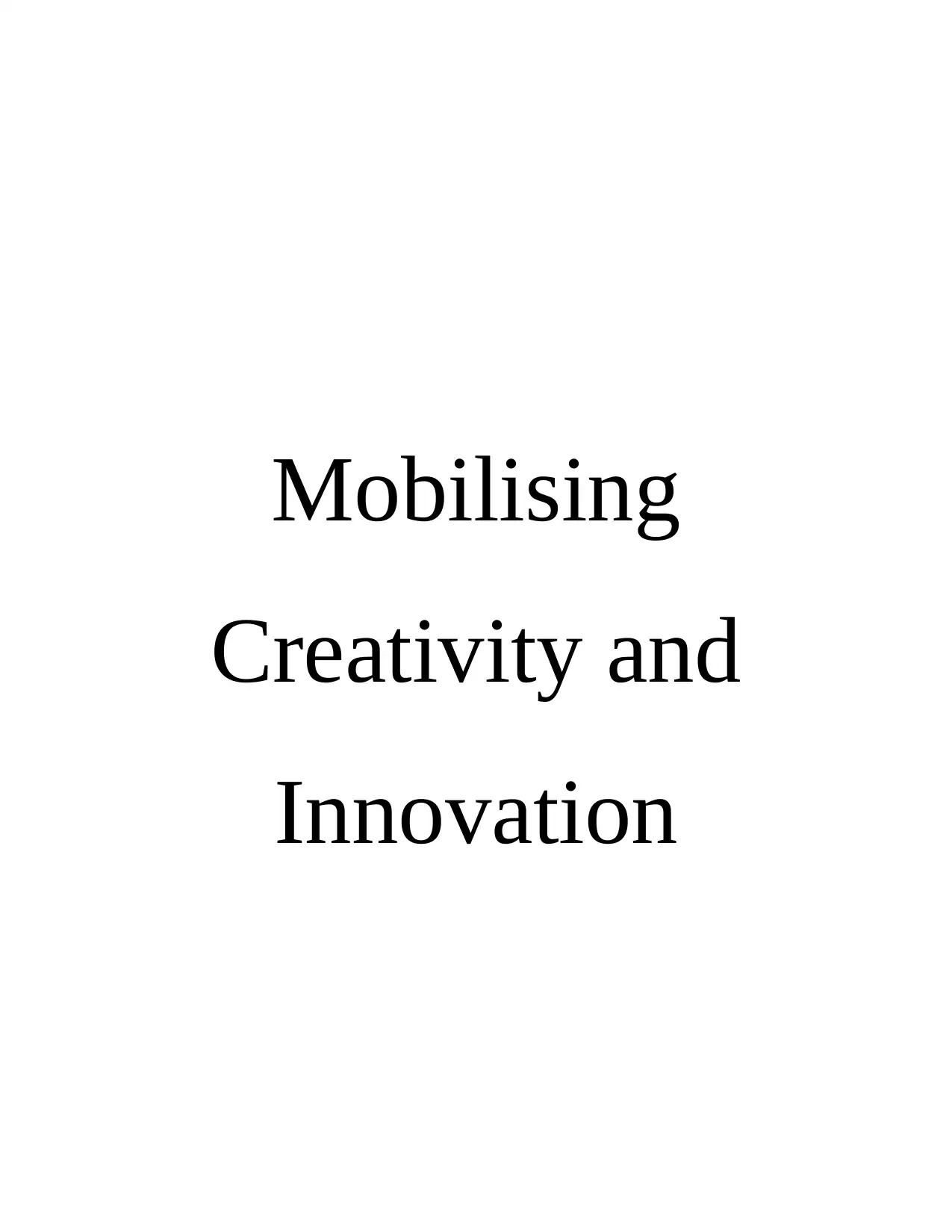
Mobilising
Creativity and
Innovation
Creativity and
Innovation
Paraphrase This Document
Need a fresh take? Get an instant paraphrase of this document with our AI Paraphraser
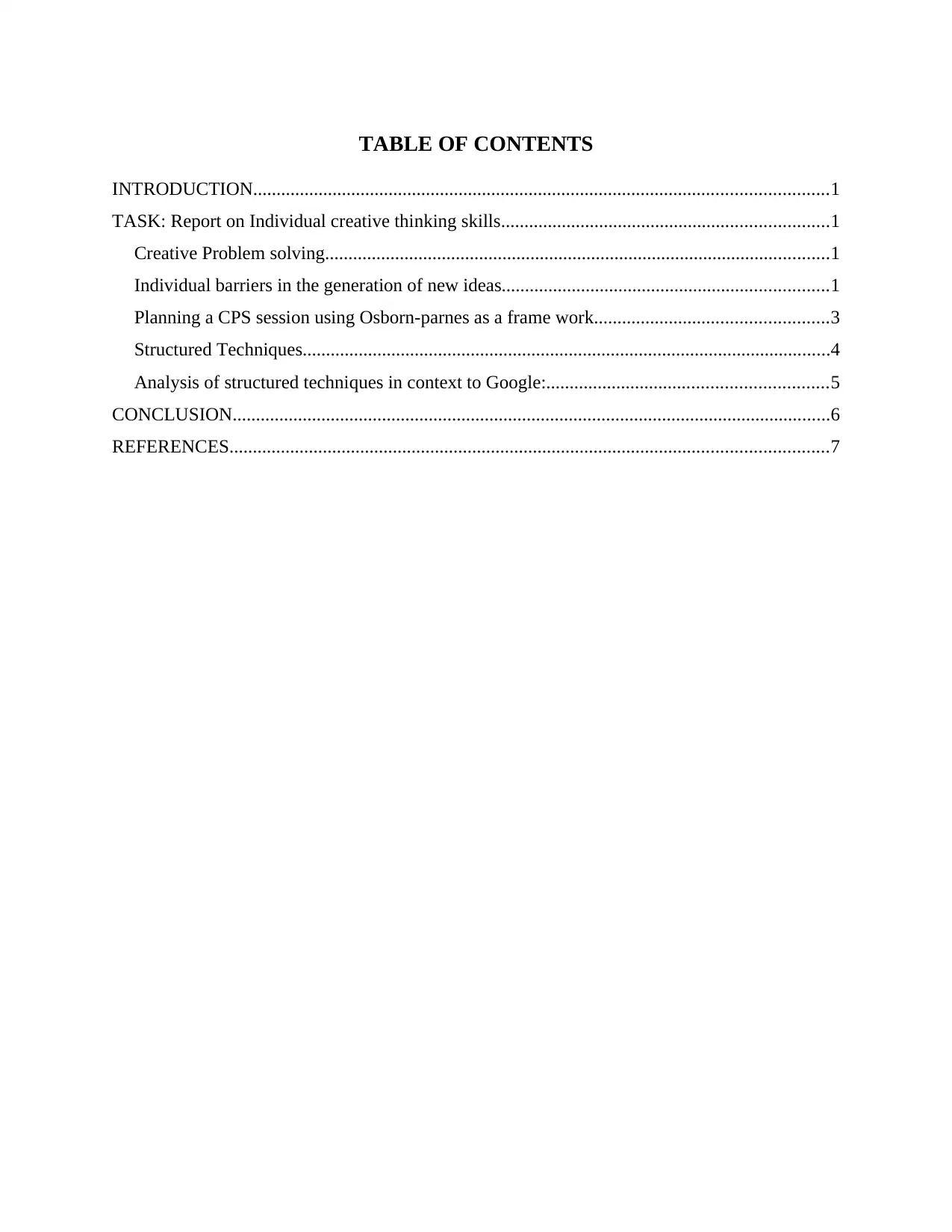
TABLE OF CONTENTS
INTRODUCTION...........................................................................................................................1
TASK: Report on Individual creative thinking skills......................................................................1
Creative Problem solving............................................................................................................1
Individual barriers in the generation of new ideas......................................................................1
Planning a CPS session using Osborn-parnes as a frame work..................................................3
Structured Techniques.................................................................................................................4
Analysis of structured techniques in context to Google:............................................................5
CONCLUSION................................................................................................................................6
REFERENCES................................................................................................................................7
INTRODUCTION...........................................................................................................................1
TASK: Report on Individual creative thinking skills......................................................................1
Creative Problem solving............................................................................................................1
Individual barriers in the generation of new ideas......................................................................1
Planning a CPS session using Osborn-parnes as a frame work..................................................3
Structured Techniques.................................................................................................................4
Analysis of structured techniques in context to Google:............................................................5
CONCLUSION................................................................................................................................6
REFERENCES................................................................................................................................7
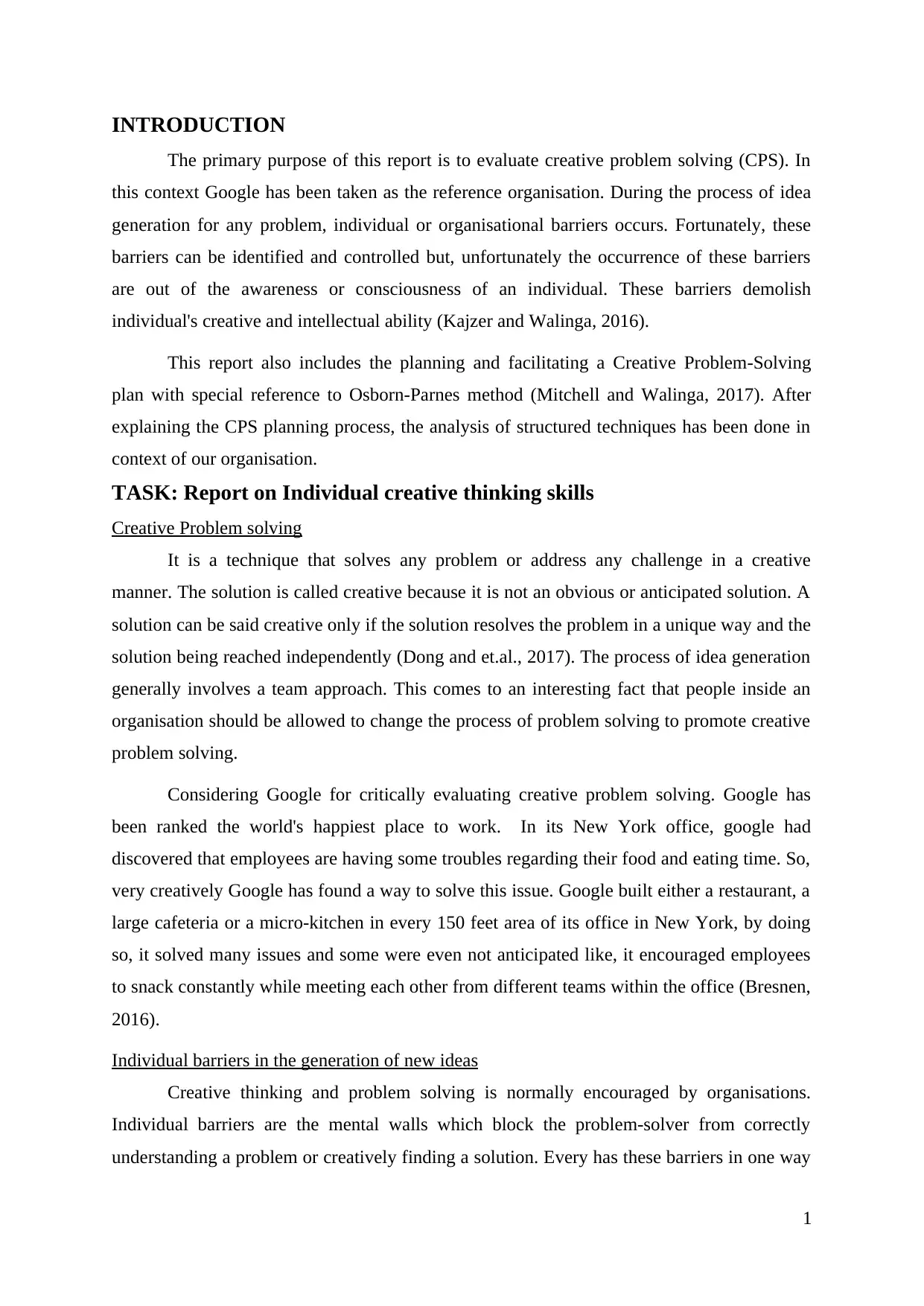
INTRODUCTION
The primary purpose of this report is to evaluate creative problem solving (CPS). In
this context Google has been taken as the reference organisation. During the process of idea
generation for any problem, individual or organisational barriers occurs. Fortunately, these
barriers can be identified and controlled but, unfortunately the occurrence of these barriers
are out of the awareness or consciousness of an individual. These barriers demolish
individual's creative and intellectual ability (Kajzer and Walinga, 2016).
This report also includes the planning and facilitating a Creative Problem-Solving
plan with special reference to Osborn-Parnes method (Mitchell and Walinga, 2017). After
explaining the CPS planning process, the analysis of structured techniques has been done in
context of our organisation.
TASK: Report on Individual creative thinking skills
Creative Problem solving
It is a technique that solves any problem or address any challenge in a creative
manner. The solution is called creative because it is not an obvious or anticipated solution. A
solution can be said creative only if the solution resolves the problem in a unique way and the
solution being reached independently (Dong and et.al., 2017). The process of idea generation
generally involves a team approach. This comes to an interesting fact that people inside an
organisation should be allowed to change the process of problem solving to promote creative
problem solving.
Considering Google for critically evaluating creative problem solving. Google has
been ranked the world's happiest place to work. In its New York office, google had
discovered that employees are having some troubles regarding their food and eating time. So,
very creatively Google has found a way to solve this issue. Google built either a restaurant, a
large cafeteria or a micro-kitchen in every 150 feet area of its office in New York, by doing
so, it solved many issues and some were even not anticipated like, it encouraged employees
to snack constantly while meeting each other from different teams within the office (Bresnen,
2016).
Individual barriers in the generation of new ideas
Creative thinking and problem solving is normally encouraged by organisations.
Individual barriers are the mental walls which block the problem-solver from correctly
understanding a problem or creatively finding a solution. Every has these barriers in one way
1
The primary purpose of this report is to evaluate creative problem solving (CPS). In
this context Google has been taken as the reference organisation. During the process of idea
generation for any problem, individual or organisational barriers occurs. Fortunately, these
barriers can be identified and controlled but, unfortunately the occurrence of these barriers
are out of the awareness or consciousness of an individual. These barriers demolish
individual's creative and intellectual ability (Kajzer and Walinga, 2016).
This report also includes the planning and facilitating a Creative Problem-Solving
plan with special reference to Osborn-Parnes method (Mitchell and Walinga, 2017). After
explaining the CPS planning process, the analysis of structured techniques has been done in
context of our organisation.
TASK: Report on Individual creative thinking skills
Creative Problem solving
It is a technique that solves any problem or address any challenge in a creative
manner. The solution is called creative because it is not an obvious or anticipated solution. A
solution can be said creative only if the solution resolves the problem in a unique way and the
solution being reached independently (Dong and et.al., 2017). The process of idea generation
generally involves a team approach. This comes to an interesting fact that people inside an
organisation should be allowed to change the process of problem solving to promote creative
problem solving.
Considering Google for critically evaluating creative problem solving. Google has
been ranked the world's happiest place to work. In its New York office, google had
discovered that employees are having some troubles regarding their food and eating time. So,
very creatively Google has found a way to solve this issue. Google built either a restaurant, a
large cafeteria or a micro-kitchen in every 150 feet area of its office in New York, by doing
so, it solved many issues and some were even not anticipated like, it encouraged employees
to snack constantly while meeting each other from different teams within the office (Bresnen,
2016).
Individual barriers in the generation of new ideas
Creative thinking and problem solving is normally encouraged by organisations.
Individual barriers are the mental walls which block the problem-solver from correctly
understanding a problem or creatively finding a solution. Every has these barriers in one way
1
⊘ This is a preview!⊘
Do you want full access?
Subscribe today to unlock all pages.

Trusted by 1+ million students worldwide
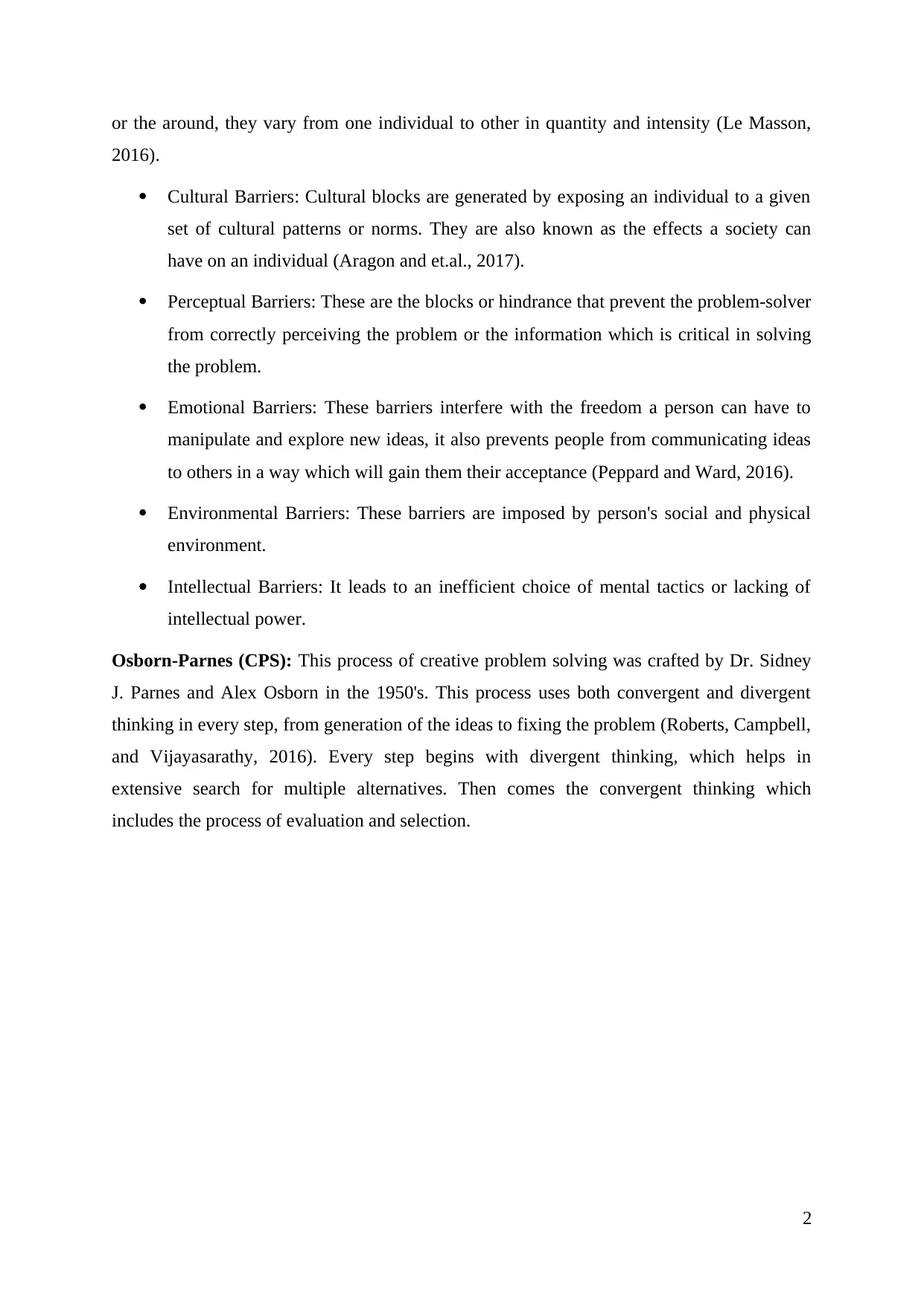
or the around, they vary from one individual to other in quantity and intensity (Le Masson,
2016).
Cultural Barriers: Cultural blocks are generated by exposing an individual to a given
set of cultural patterns or norms. They are also known as the effects a society can
have on an individual (Aragon and et.al., 2017).
Perceptual Barriers: These are the blocks or hindrance that prevent the problem-solver
from correctly perceiving the problem or the information which is critical in solving
the problem.
Emotional Barriers: These barriers interfere with the freedom a person can have to
manipulate and explore new ideas, it also prevents people from communicating ideas
to others in a way which will gain them their acceptance (Peppard and Ward, 2016).
Environmental Barriers: These barriers are imposed by person's social and physical
environment.
Intellectual Barriers: It leads to an inefficient choice of mental tactics or lacking of
intellectual power.
Osborn-Parnes (CPS): This process of creative problem solving was crafted by Dr. Sidney
J. Parnes and Alex Osborn in the 1950's. This process uses both convergent and divergent
thinking in every step, from generation of the ideas to fixing the problem (Roberts, Campbell,
and Vijayasarathy, 2016). Every step begins with divergent thinking, which helps in
extensive search for multiple alternatives. Then comes the convergent thinking which
includes the process of evaluation and selection.
2
2016).
Cultural Barriers: Cultural blocks are generated by exposing an individual to a given
set of cultural patterns or norms. They are also known as the effects a society can
have on an individual (Aragon and et.al., 2017).
Perceptual Barriers: These are the blocks or hindrance that prevent the problem-solver
from correctly perceiving the problem or the information which is critical in solving
the problem.
Emotional Barriers: These barriers interfere with the freedom a person can have to
manipulate and explore new ideas, it also prevents people from communicating ideas
to others in a way which will gain them their acceptance (Peppard and Ward, 2016).
Environmental Barriers: These barriers are imposed by person's social and physical
environment.
Intellectual Barriers: It leads to an inefficient choice of mental tactics or lacking of
intellectual power.
Osborn-Parnes (CPS): This process of creative problem solving was crafted by Dr. Sidney
J. Parnes and Alex Osborn in the 1950's. This process uses both convergent and divergent
thinking in every step, from generation of the ideas to fixing the problem (Roberts, Campbell,
and Vijayasarathy, 2016). Every step begins with divergent thinking, which helps in
extensive search for multiple alternatives. Then comes the convergent thinking which
includes the process of evaluation and selection.
2
Paraphrase This Document
Need a fresh take? Get an instant paraphrase of this document with our AI Paraphraser
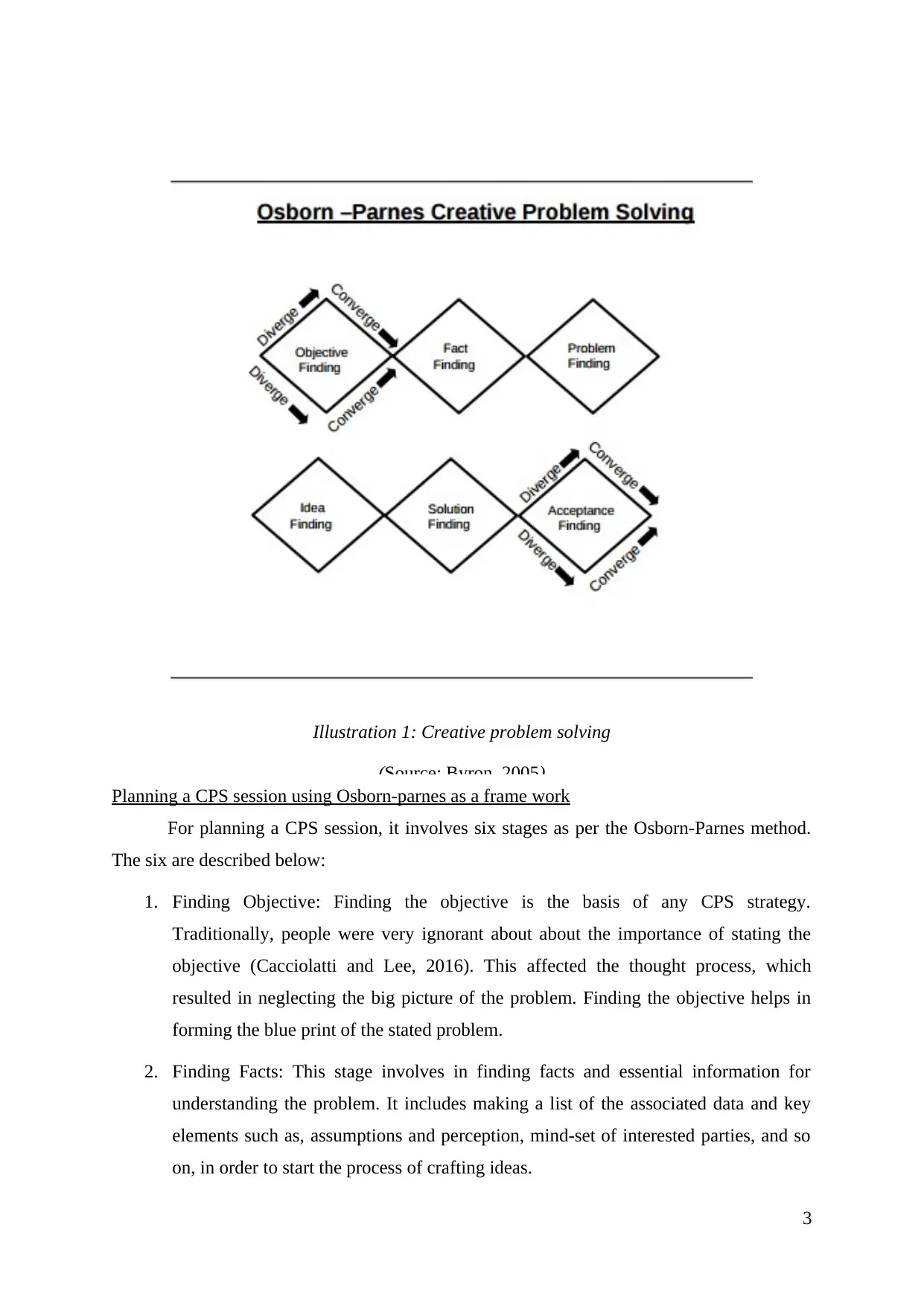
Planning a CPS session using Osborn-parnes as a frame work
For planning a CPS session, it involves six stages as per the Osborn-Parnes method.
The six are described below:
1. Finding Objective: Finding the objective is the basis of any CPS strategy.
Traditionally, people were very ignorant about about the importance of stating the
objective (Cacciolatti and Lee, 2016). This affected the thought process, which
resulted in neglecting the big picture of the problem. Finding the objective helps in
forming the blue print of the stated problem.
2. Finding Facts: This stage involves in finding facts and essential information for
understanding the problem. It includes making a list of the associated data and key
elements such as, assumptions and perception, mind-set of interested parties, and so
on, in order to start the process of crafting ideas.
3
Illustration 1: Creative problem solving
(Source: Byron, 2005)
For planning a CPS session, it involves six stages as per the Osborn-Parnes method.
The six are described below:
1. Finding Objective: Finding the objective is the basis of any CPS strategy.
Traditionally, people were very ignorant about about the importance of stating the
objective (Cacciolatti and Lee, 2016). This affected the thought process, which
resulted in neglecting the big picture of the problem. Finding the objective helps in
forming the blue print of the stated problem.
2. Finding Facts: This stage involves in finding facts and essential information for
understanding the problem. It includes making a list of the associated data and key
elements such as, assumptions and perception, mind-set of interested parties, and so
on, in order to start the process of crafting ideas.
3
Illustration 1: Creative problem solving
(Source: Byron, 2005)
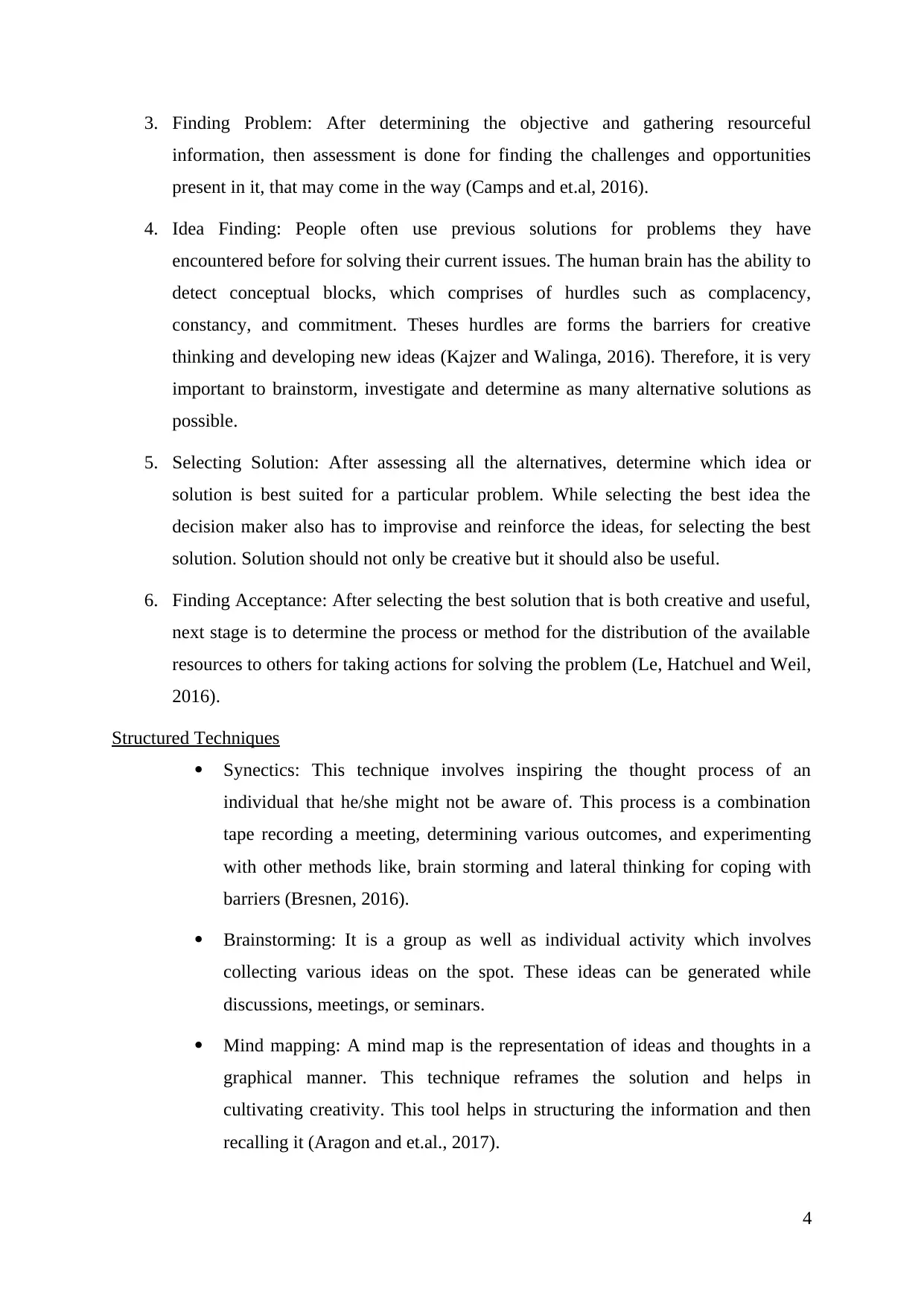
3. Finding Problem: After determining the objective and gathering resourceful
information, then assessment is done for finding the challenges and opportunities
present in it, that may come in the way (Camps and et.al, 2016).
4. Idea Finding: People often use previous solutions for problems they have
encountered before for solving their current issues. The human brain has the ability to
detect conceptual blocks, which comprises of hurdles such as complacency,
constancy, and commitment. Theses hurdles are forms the barriers for creative
thinking and developing new ideas (Kajzer and Walinga, 2016). Therefore, it is very
important to brainstorm, investigate and determine as many alternative solutions as
possible.
5. Selecting Solution: After assessing all the alternatives, determine which idea or
solution is best suited for a particular problem. While selecting the best idea the
decision maker also has to improvise and reinforce the ideas, for selecting the best
solution. Solution should not only be creative but it should also be useful.
6. Finding Acceptance: After selecting the best solution that is both creative and useful,
next stage is to determine the process or method for the distribution of the available
resources to others for taking actions for solving the problem (Le, Hatchuel and Weil,
2016).
Structured Techniques
Synectics: This technique involves inspiring the thought process of an
individual that he/she might not be aware of. This process is a combination
tape recording a meeting, determining various outcomes, and experimenting
with other methods like, brain storming and lateral thinking for coping with
barriers (Bresnen, 2016).
Brainstorming: It is a group as well as individual activity which involves
collecting various ideas on the spot. These ideas can be generated while
discussions, meetings, or seminars.
Mind mapping: A mind map is the representation of ideas and thoughts in a
graphical manner. This technique reframes the solution and helps in
cultivating creativity. This tool helps in structuring the information and then
recalling it (Aragon and et.al., 2017).
4
information, then assessment is done for finding the challenges and opportunities
present in it, that may come in the way (Camps and et.al, 2016).
4. Idea Finding: People often use previous solutions for problems they have
encountered before for solving their current issues. The human brain has the ability to
detect conceptual blocks, which comprises of hurdles such as complacency,
constancy, and commitment. Theses hurdles are forms the barriers for creative
thinking and developing new ideas (Kajzer and Walinga, 2016). Therefore, it is very
important to brainstorm, investigate and determine as many alternative solutions as
possible.
5. Selecting Solution: After assessing all the alternatives, determine which idea or
solution is best suited for a particular problem. While selecting the best idea the
decision maker also has to improvise and reinforce the ideas, for selecting the best
solution. Solution should not only be creative but it should also be useful.
6. Finding Acceptance: After selecting the best solution that is both creative and useful,
next stage is to determine the process or method for the distribution of the available
resources to others for taking actions for solving the problem (Le, Hatchuel and Weil,
2016).
Structured Techniques
Synectics: This technique involves inspiring the thought process of an
individual that he/she might not be aware of. This process is a combination
tape recording a meeting, determining various outcomes, and experimenting
with other methods like, brain storming and lateral thinking for coping with
barriers (Bresnen, 2016).
Brainstorming: It is a group as well as individual activity which involves
collecting various ideas on the spot. These ideas can be generated while
discussions, meetings, or seminars.
Mind mapping: A mind map is the representation of ideas and thoughts in a
graphical manner. This technique reframes the solution and helps in
cultivating creativity. This tool helps in structuring the information and then
recalling it (Aragon and et.al., 2017).
4
⊘ This is a preview!⊘
Do you want full access?
Subscribe today to unlock all pages.

Trusted by 1+ million students worldwide
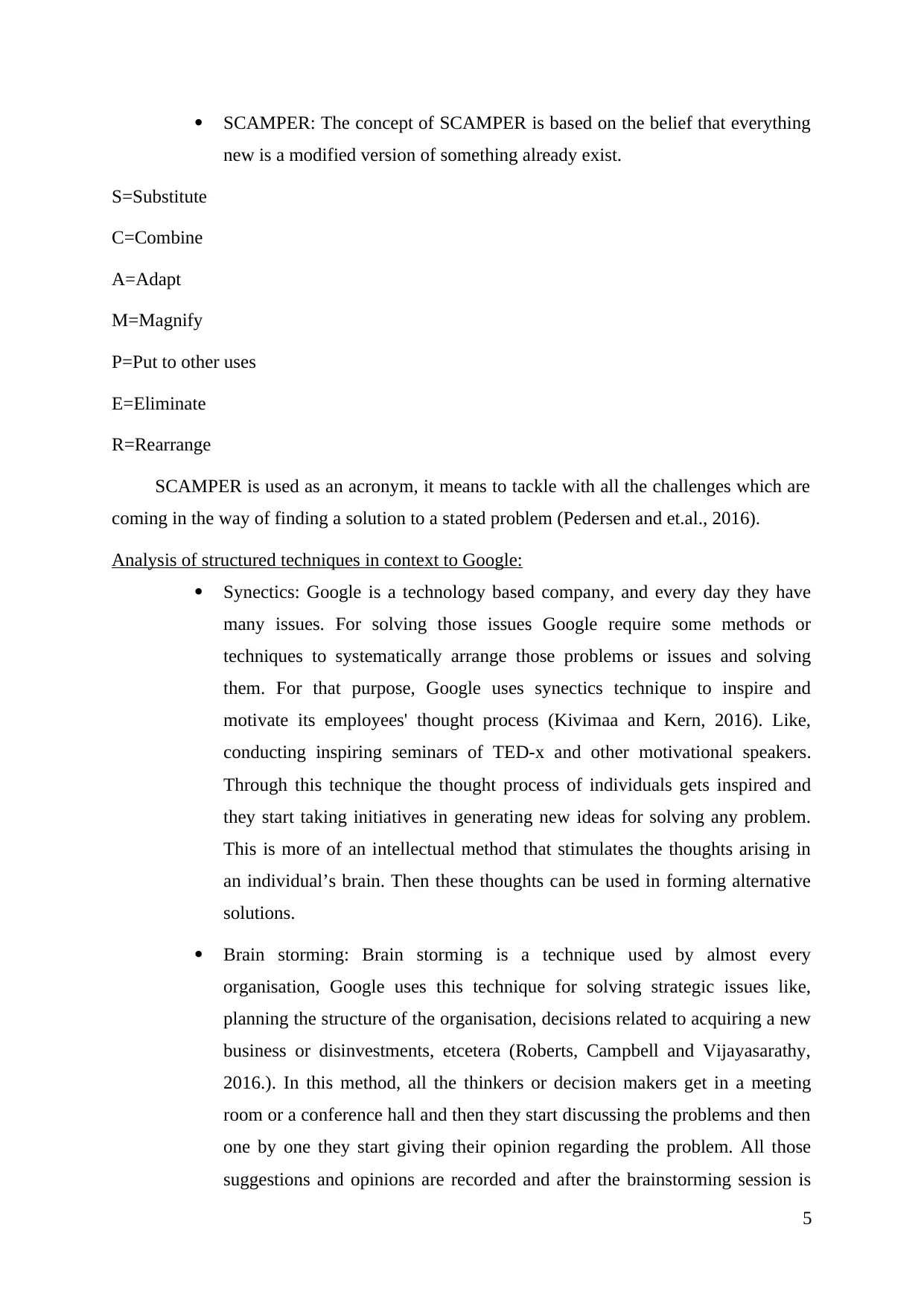
SCAMPER: The concept of SCAMPER is based on the belief that everything
new is a modified version of something already exist.
S=Substitute
C=Combine
A=Adapt
M=Magnify
P=Put to other uses
E=Eliminate
R=Rearrange
SCAMPER is used as an acronym, it means to tackle with all the challenges which are
coming in the way of finding a solution to a stated problem (Pedersen and et.al., 2016).
Analysis of structured techniques in context to Google:
Synectics: Google is a technology based company, and every day they have
many issues. For solving those issues Google require some methods or
techniques to systematically arrange those problems or issues and solving
them. For that purpose, Google uses synectics technique to inspire and
motivate its employees' thought process (Kivimaa and Kern, 2016). Like,
conducting inspiring seminars of TED-x and other motivational speakers.
Through this technique the thought process of individuals gets inspired and
they start taking initiatives in generating new ideas for solving any problem.
This is more of an intellectual method that stimulates the thoughts arising in
an individual’s brain. Then these thoughts can be used in forming alternative
solutions.
Brain storming: Brain storming is a technique used by almost every
organisation, Google uses this technique for solving strategic issues like,
planning the structure of the organisation, decisions related to acquiring a new
business or disinvestments, etcetera (Roberts, Campbell and Vijayasarathy,
2016.). In this method, all the thinkers or decision makers get in a meeting
room or a conference hall and then they start discussing the problems and then
one by one they start giving their opinion regarding the problem. All those
suggestions and opinions are recorded and after the brainstorming session is
5
new is a modified version of something already exist.
S=Substitute
C=Combine
A=Adapt
M=Magnify
P=Put to other uses
E=Eliminate
R=Rearrange
SCAMPER is used as an acronym, it means to tackle with all the challenges which are
coming in the way of finding a solution to a stated problem (Pedersen and et.al., 2016).
Analysis of structured techniques in context to Google:
Synectics: Google is a technology based company, and every day they have
many issues. For solving those issues Google require some methods or
techniques to systematically arrange those problems or issues and solving
them. For that purpose, Google uses synectics technique to inspire and
motivate its employees' thought process (Kivimaa and Kern, 2016). Like,
conducting inspiring seminars of TED-x and other motivational speakers.
Through this technique the thought process of individuals gets inspired and
they start taking initiatives in generating new ideas for solving any problem.
This is more of an intellectual method that stimulates the thoughts arising in
an individual’s brain. Then these thoughts can be used in forming alternative
solutions.
Brain storming: Brain storming is a technique used by almost every
organisation, Google uses this technique for solving strategic issues like,
planning the structure of the organisation, decisions related to acquiring a new
business or disinvestments, etcetera (Roberts, Campbell and Vijayasarathy,
2016.). In this method, all the thinkers or decision makers get in a meeting
room or a conference hall and then they start discussing the problems and then
one by one they start giving their opinion regarding the problem. All those
suggestions and opinions are recorded and after the brainstorming session is
5
Paraphrase This Document
Need a fresh take? Get an instant paraphrase of this document with our AI Paraphraser
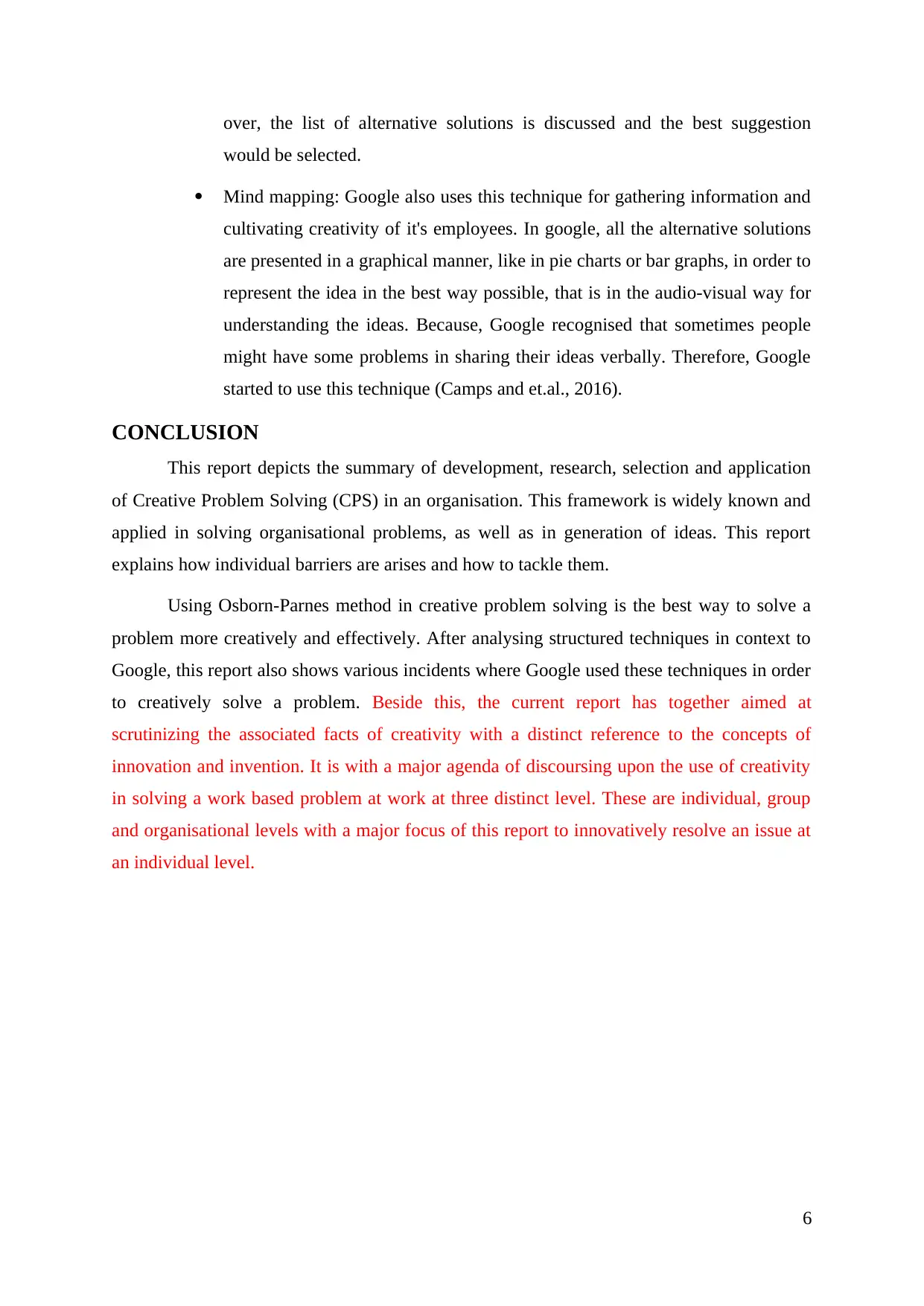
over, the list of alternative solutions is discussed and the best suggestion
would be selected.
Mind mapping: Google also uses this technique for gathering information and
cultivating creativity of it's employees. In google, all the alternative solutions
are presented in a graphical manner, like in pie charts or bar graphs, in order to
represent the idea in the best way possible, that is in the audio-visual way for
understanding the ideas. Because, Google recognised that sometimes people
might have some problems in sharing their ideas verbally. Therefore, Google
started to use this technique (Camps and et.al., 2016).
CONCLUSION
This report depicts the summary of development, research, selection and application
of Creative Problem Solving (CPS) in an organisation. This framework is widely known and
applied in solving organisational problems, as well as in generation of ideas. This report
explains how individual barriers are arises and how to tackle them.
Using Osborn-Parnes method in creative problem solving is the best way to solve a
problem more creatively and effectively. After analysing structured techniques in context to
Google, this report also shows various incidents where Google used these techniques in order
to creatively solve a problem. Beside this, the current report has together aimed at
scrutinizing the associated facts of creativity with a distinct reference to the concepts of
innovation and invention. It is with a major agenda of discoursing upon the use of creativity
in solving a work based problem at work at three distinct level. These are individual, group
and organisational levels with a major focus of this report to innovatively resolve an issue at
an individual level.
6
would be selected.
Mind mapping: Google also uses this technique for gathering information and
cultivating creativity of it's employees. In google, all the alternative solutions
are presented in a graphical manner, like in pie charts or bar graphs, in order to
represent the idea in the best way possible, that is in the audio-visual way for
understanding the ideas. Because, Google recognised that sometimes people
might have some problems in sharing their ideas verbally. Therefore, Google
started to use this technique (Camps and et.al., 2016).
CONCLUSION
This report depicts the summary of development, research, selection and application
of Creative Problem Solving (CPS) in an organisation. This framework is widely known and
applied in solving organisational problems, as well as in generation of ideas. This report
explains how individual barriers are arises and how to tackle them.
Using Osborn-Parnes method in creative problem solving is the best way to solve a
problem more creatively and effectively. After analysing structured techniques in context to
Google, this report also shows various incidents where Google used these techniques in order
to creatively solve a problem. Beside this, the current report has together aimed at
scrutinizing the associated facts of creativity with a distinct reference to the concepts of
innovation and invention. It is with a major agenda of discoursing upon the use of creativity
in solving a work based problem at work at three distinct level. These are individual, group
and organisational levels with a major focus of this report to innovatively resolve an issue at
an individual level.
6
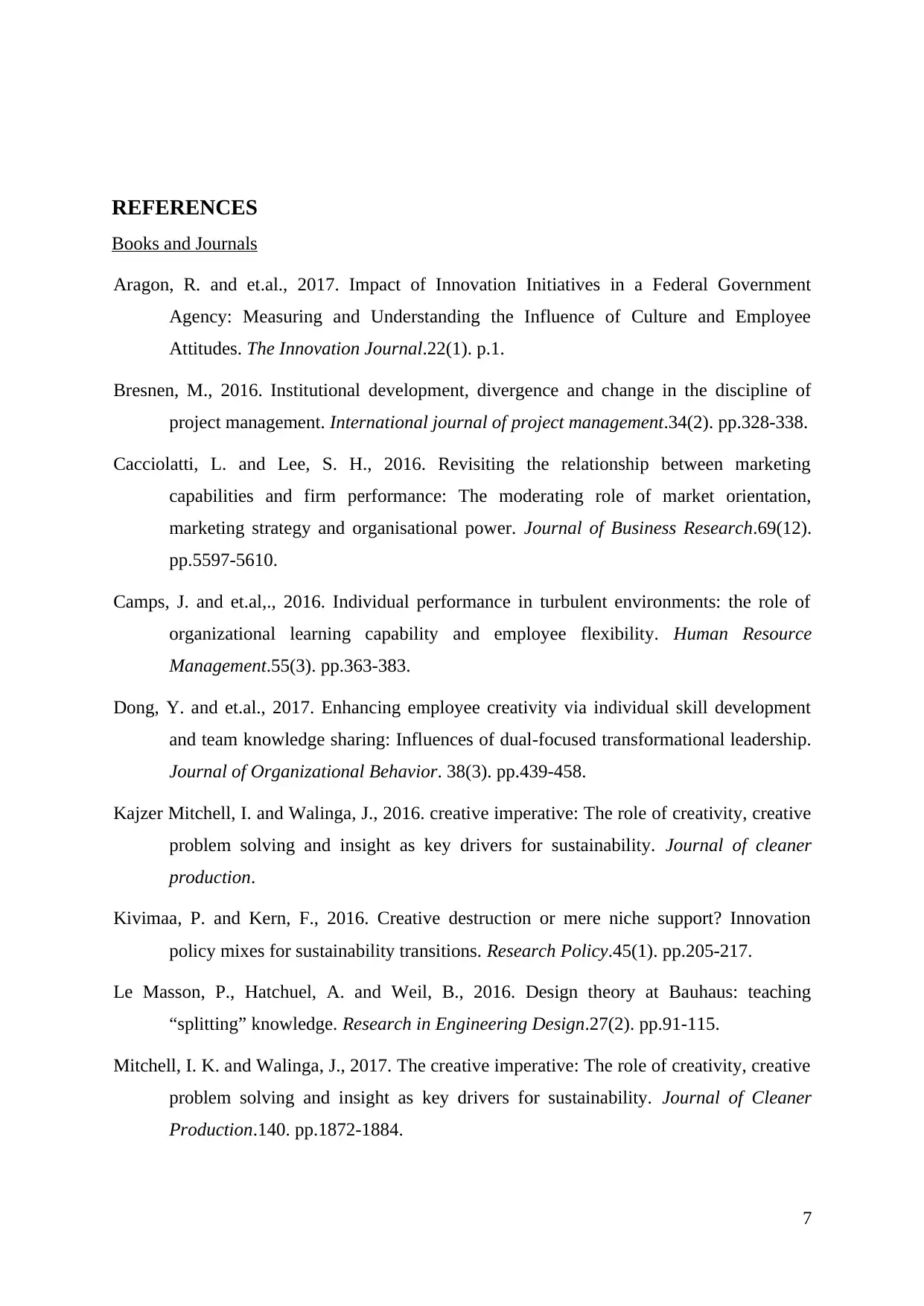
REFERENCES
Books and Journals
Aragon, R. and et.al., 2017. Impact of Innovation Initiatives in a Federal Government
Agency: Measuring and Understanding the Influence of Culture and Employee
Attitudes. The Innovation Journal.22(1). p.1.
Bresnen, M., 2016. Institutional development, divergence and change in the discipline of
project management. International journal of project management.34(2). pp.328-338.
Cacciolatti, L. and Lee, S. H., 2016. Revisiting the relationship between marketing
capabilities and firm performance: The moderating role of market orientation,
marketing strategy and organisational power. Journal of Business Research.69(12).
pp.5597-5610.
Camps, J. and et.al,., 2016. Individual performance in turbulent environments: the role of
organizational learning capability and employee flexibility. Human Resource
Management.55(3). pp.363-383.
Dong, Y. and et.al., 2017. Enhancing employee creativity via individual skill development
and team knowledge sharing: Influences of dual‐focused transformational leadership.
Journal of Organizational Behavior. 38(3). pp.439-458.
Kajzer Mitchell, I. and Walinga, J., 2016. creative imperative: The role of creativity, creative
problem solving and insight as key drivers for sustainability. Journal of cleaner
production.
Kivimaa, P. and Kern, F., 2016. Creative destruction or mere niche support? Innovation
policy mixes for sustainability transitions. Research Policy.45(1). pp.205-217.
Le Masson, P., Hatchuel, A. and Weil, B., 2016. Design theory at Bauhaus: teaching
“splitting” knowledge. Research in Engineering Design.27(2). pp.91-115.
Mitchell, I. K. and Walinga, J., 2017. The creative imperative: The role of creativity, creative
problem solving and insight as key drivers for sustainability. Journal of Cleaner
Production.140. pp.1872-1884.
7
Books and Journals
Aragon, R. and et.al., 2017. Impact of Innovation Initiatives in a Federal Government
Agency: Measuring and Understanding the Influence of Culture and Employee
Attitudes. The Innovation Journal.22(1). p.1.
Bresnen, M., 2016. Institutional development, divergence and change in the discipline of
project management. International journal of project management.34(2). pp.328-338.
Cacciolatti, L. and Lee, S. H., 2016. Revisiting the relationship between marketing
capabilities and firm performance: The moderating role of market orientation,
marketing strategy and organisational power. Journal of Business Research.69(12).
pp.5597-5610.
Camps, J. and et.al,., 2016. Individual performance in turbulent environments: the role of
organizational learning capability and employee flexibility. Human Resource
Management.55(3). pp.363-383.
Dong, Y. and et.al., 2017. Enhancing employee creativity via individual skill development
and team knowledge sharing: Influences of dual‐focused transformational leadership.
Journal of Organizational Behavior. 38(3). pp.439-458.
Kajzer Mitchell, I. and Walinga, J., 2016. creative imperative: The role of creativity, creative
problem solving and insight as key drivers for sustainability. Journal of cleaner
production.
Kivimaa, P. and Kern, F., 2016. Creative destruction or mere niche support? Innovation
policy mixes for sustainability transitions. Research Policy.45(1). pp.205-217.
Le Masson, P., Hatchuel, A. and Weil, B., 2016. Design theory at Bauhaus: teaching
“splitting” knowledge. Research in Engineering Design.27(2). pp.91-115.
Mitchell, I. K. and Walinga, J., 2017. The creative imperative: The role of creativity, creative
problem solving and insight as key drivers for sustainability. Journal of Cleaner
Production.140. pp.1872-1884.
7
⊘ This is a preview!⊘
Do you want full access?
Subscribe today to unlock all pages.

Trusted by 1+ million students worldwide
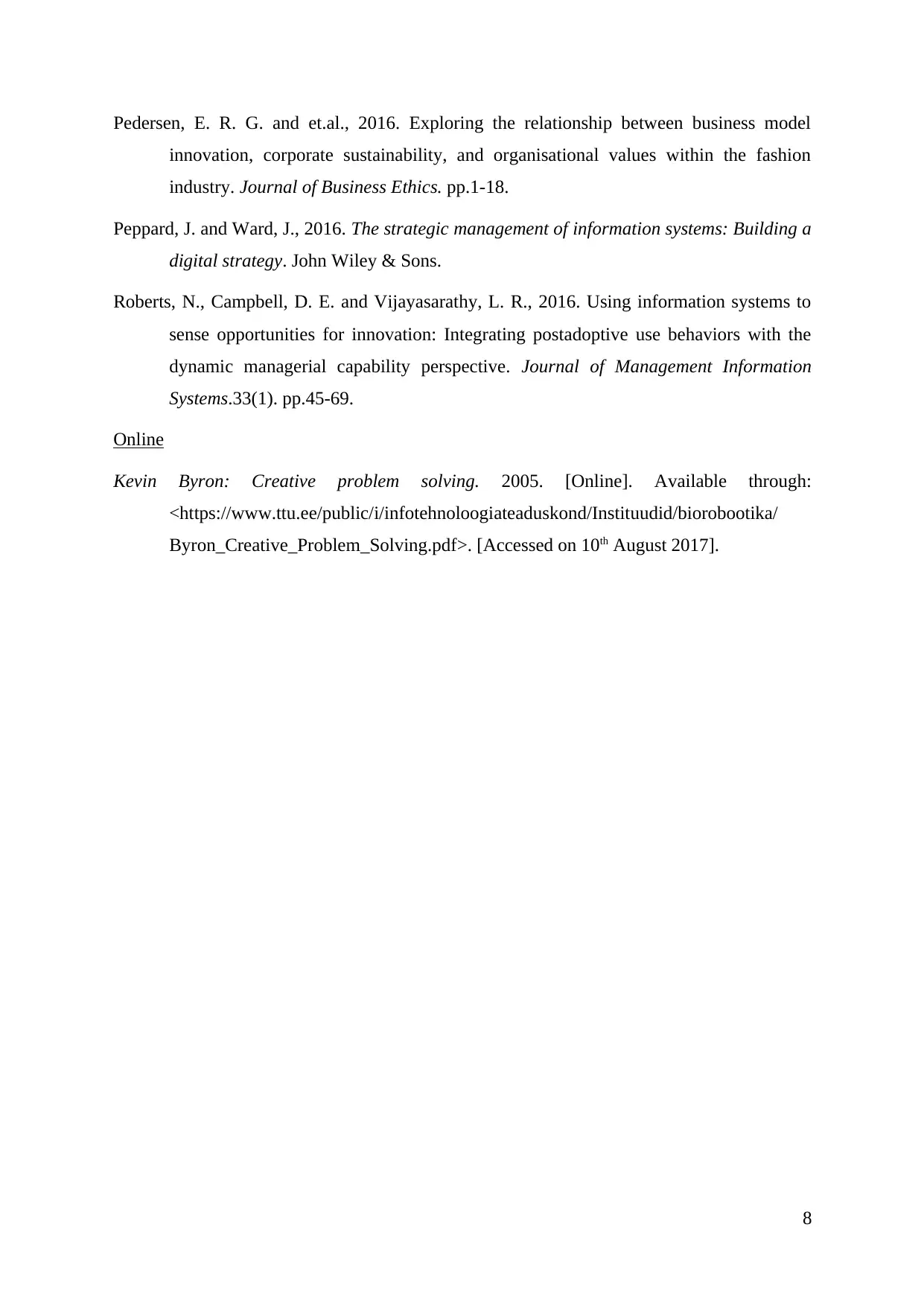
Pedersen, E. R. G. and et.al., 2016. Exploring the relationship between business model
innovation, corporate sustainability, and organisational values within the fashion
industry. Journal of Business Ethics. pp.1-18.
Peppard, J. and Ward, J., 2016. The strategic management of information systems: Building a
digital strategy. John Wiley & Sons.
Roberts, N., Campbell, D. E. and Vijayasarathy, L. R., 2016. Using information systems to
sense opportunities for innovation: Integrating postadoptive use behaviors with the
dynamic managerial capability perspective. Journal of Management Information
Systems.33(1). pp.45-69.
Online
Kevin Byron: Creative problem solving. 2005. [Online]. Available through:
<https://www.ttu.ee/public/i/infotehnoloogiateaduskond/Instituudid/biorobootika/
Byron_Creative_Problem_Solving.pdf>. [Accessed on 10th August 2017].
8
innovation, corporate sustainability, and organisational values within the fashion
industry. Journal of Business Ethics. pp.1-18.
Peppard, J. and Ward, J., 2016. The strategic management of information systems: Building a
digital strategy. John Wiley & Sons.
Roberts, N., Campbell, D. E. and Vijayasarathy, L. R., 2016. Using information systems to
sense opportunities for innovation: Integrating postadoptive use behaviors with the
dynamic managerial capability perspective. Journal of Management Information
Systems.33(1). pp.45-69.
Online
Kevin Byron: Creative problem solving. 2005. [Online]. Available through:
<https://www.ttu.ee/public/i/infotehnoloogiateaduskond/Instituudid/biorobootika/
Byron_Creative_Problem_Solving.pdf>. [Accessed on 10th August 2017].
8
1 out of 10
Related Documents
Your All-in-One AI-Powered Toolkit for Academic Success.
+13062052269
info@desklib.com
Available 24*7 on WhatsApp / Email
![[object Object]](/_next/static/media/star-bottom.7253800d.svg)
Unlock your academic potential
Copyright © 2020–2025 A2Z Services. All Rights Reserved. Developed and managed by ZUCOL.



